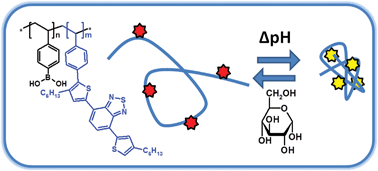The glucose blood level should be carefully monitored in people suffering from diabetes mellitus. In this view, a wide variety of glucose sensing molecules have been developed in the recent decades, based on boronic acid functionalized dyes that change colour or emission in the presence of glucose. The incorporation of boronic acid moieties as polymer side chains
indeed results in glucose responsive polymers that are insoluble in the absence of glucose and are solubilised in the presence of glucose due to the higher polarity of the stabilized tetragonal anionic boronic acid form. The present work of Hoogenboom and co-workers aims at developping a simple macromolecular synthesis procedure for the preparation of boronic acid containing polymers, making them accessible to a wide range of polymer scientists, beyond polymer chemists. They used a combination of commercial products; the unprotected 4-vinylphenylboronic acid (4-VBA) and the BlocBuilder alkoxyamine initiator for nitroxide mediated polymerization (NMP). The developed NMP method opens up new avenues towards 4-VBA containing polymers to evaluate glucose responsivity of various copolymers, including block copolymers for autonomous insulin delivery upon increasing glucose concentration.
Direct nitroxide mediated (co)polymerization of 4-vinylphenylboronic acid as route towards sugar sensors by Gertjan Vancoillie , Simon Pelz , Elisabeth Holder and Richard Hoogenboom, Polym. Chem., 2012, 3, 1726-1729.
To keep up-to-date with all the latest research, sign up for the journal’s e-alerts or RSS feeds or follow Polymer Chemistryon Twitter or Facebook.











